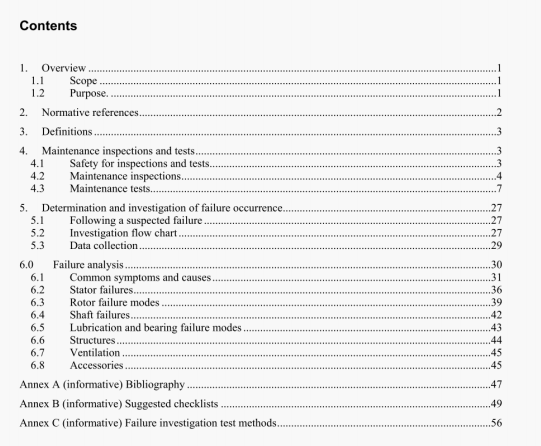IEEE Std 1415:2006 pdf free download.IEEE Guide for Induction Machinery Maintenance Testing and Failure Analysis.
Machines in storage should also have external inspections performed. Filling the oil reservoir with vapor harrier oil, the occasional rotation of the shaft, and verification of space heater operation are important items that should be included in maintenance storage procedures. Periodically evaluate the winding condition to ensure that deterioration has not occurred.
4.2.2 Disassembly and inspection of components
Dismantling a machine for visual inspection is an expensive and operationally disruptive decision. The decision to dismantle a non-critical machine should be carefully evaluated based on the analysis of trendable and pass/fail tests. ally abnormal noise, vibration or odor, unexplained operation of protective relays, and industry experience with similar machines and applications. In addition to cost, a disadvantage of machine disassembly is the possibility of damage to components by mishandling and improper reassembly. A detailed visual inspection may be the only nans of evaluating the physical condition of stator windings. rotor windings and the cores. A visual inspection may reveal the presence of dirt, oil or moisture, damage from foreign material, broken or cracked components. loose winding ties or abraded insulation. A simple visual inspection of the dismantled machine may reinforce findings of the tests given in Table I and also facilitate the root cause analysis.
4.2.2.1 Stator inspection
In general, while exercising appropriate safety precautions, examine everything that can be seen, and touch everything that can be reached. Contamination of’ coil surfaces will lower insulation strength and block heat transfer. The most common contaminants are oil, moisture, corrosive vapors, and airborne particles.
An examination of the stator winding should be made for insulating tape separation or cracks. Particular attention should be paid to the areas immediately adjacent to the core. Modem thermosetting coils do not usually exhibit tape separations. but may fail if cracks develop.
Deterioration of insulation can result from cumulative thermal aging. Examination of coils might reveal a general dark color, swelling into ventilation ducts, or a lack of firmness of the insulation: these conditions indicate a loss of bonding of the insulation layers.
Abrasion of stator wedges and coils by abrasive contaminants is occasionally encountered with machines. Boiler fans are particularly susceptible. The eroding effects of abrasive contaminates against the coil insulation surfaces are particularly damaging at air vents and on the coils at the core edge opposite the rotor fan.
The tightness of all coil bracing should be verified. Check the various components of the endwinding bracing system including surge rings. Visible cracks, especially those greater than 25—50 micrometers (0.001—0.002 inches) in the blocking and bracing system are signs of differential movement between components. If not corrected, these cracks will worsen and may eventually lead to winding failure. The endwinding bracing structure should be kept as tight as possible, with no movement noted when forced by hand or tapped.
IEEE Std 1415:2006 pdf free download
